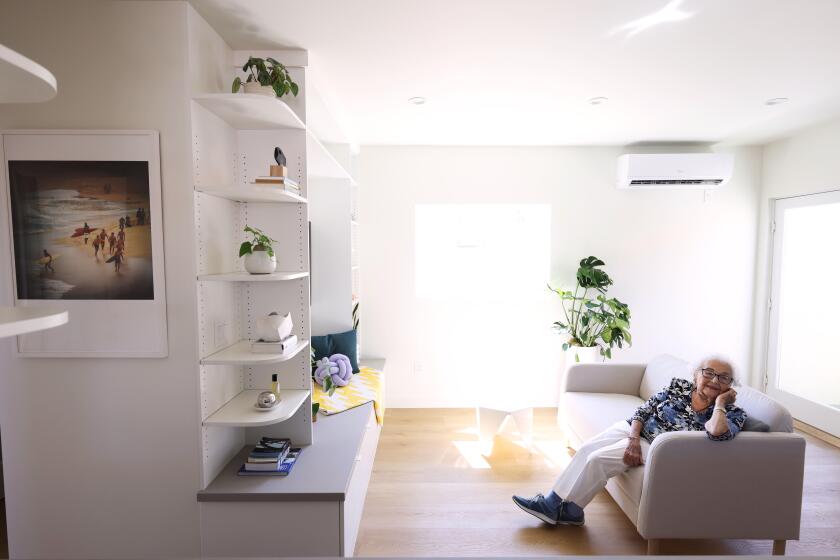Architectural Formula of 2 Plus 2 Equals Success : Santa Monica Principals Collaborate on Projects
Ask the four principals of two up-and-coming architectural firms how they perceive their work, and you get four different answers.
Ask them how four can work better than one, and you’re given an interesting formula for moving upward in today’s competitive architectural community.
The principals of Solberg & Lowe and the Felsenthal Paul Partnership have joined forces in a loose partnership not unlike members of a syndication group.
“In addition to having a good computer-aided design and drafting system and maintaining a good relationship with one’s banker, we have found that a friendly collaboration with other architects makes good business sense,” commented Richard Solberg, a former managing and design partner at Johannes Van Tilburg & Partners.
Keep Separate Firms
The two aggressive young firms operate under one roof, under one management and share a supportive staff of 18 (of whom seven are registered architects), while remaining as separate company entities.
Solberg & Lowe, which has been on the local scene longer than the Felsenthal Paul Partnership, provides most of the production and management responsibilities for the projects, enabling the principals of both firms to design and market projects beyond a normal and affordable staffing capability.
“This arrangement has increased exposure and credibility for both firms,” explained Allen Felsenthal, who is not an architect but whose expertise is extensive in interior design and marketing. He has served as director of marketing/interiors for Welton Becket Associates and was executive vice president for Stanley Felderman Ltd.
The shared philosophy that provides the foundation for both firms is simply stated: A principal is in charge of every project and his involvement extends through all phases of design and construction. “We also believe in developing close working relationships with local government and citizens groups to ensure a project’s successful completion,” Felsenthal said. The ultimate bonus of the business relationship, the foursome agrees, has been the resulting synergism.
“We are more effective combining our talents than working individually to achieve the same goals. And since our professional abilities are interchangeable, we are constantly challenged, both creatively and intellectually, and benefit from the input we provide to each other’s projects,” added Douglas A. Lowe, who was principal in charge of VCA ‘s commercial division prior to becoming a partner with Solberg.
The firms’ Santa Monica office at Pico Boulevard and Main Street, Solberg said, is “as much a statement of ego as it is an example of our philosophy.”
Constructing their office by enclosing and retaining the elements of a former gas station (including the use of the main hydraulic hoist as the base of their conference table), was intended, in the architect’s words, as “a signal to the community that you can make a silk purse out of a sow’s ear. You don’t have to spend a fortune to make something look good and original.
“It has become our billboard, although nowhere on the building do our names appear. I’ve never worked in any office where clients have slipped their business cards into our mail slot with the request for a call about a new project.”
While the two firms rely on computer-aided design support, its principals steer clear of dependency on the system. “The result could be a sameness. We like to think of every new contract as providing us with a clean sheet of paper,” Solberg explained.
Lowe added, “It’s not as if we’re reinventing the wheel for each client, but we are, after all, a service profession and the client’s contribution should affect positively our designs for them.”
A series of projects has resulted in metaphorical interpretation, tying in with both client and site needs. Solberg and Lowe’s most challenging current project is the proposed design for Cape Malibu Resort in Oxnard by Coast Resort Properties, on one of the few remaining developable beach frontages in Southern California. The project, under consideration by the city of Oxnard, would consist of a 400-room hotel, with 30,000 square feet devoted to a trade center and an adjoining a 36-hole golf course.
“Borrowing from the gentle rolling sand dunes and the pounding surf, we’ve organized the lobby and public spaces between two low-rise wings of rooms. Cresting over the top of this lobby is a huge wave of blue-green glass that appears to have been rolled in from the sea, poised to crash on the sand below,” Lowe explained.
Another subtle use of the architectural metaphor, a combined effort of the two firms, is seen in a project for the Santa Monica Airport Administration, under construction, that consists of a mixed-use building for office use, a restaurant and aircraft museum. The concept was based on the image of airport offices being sheltered under a giant wing, and the designers have integrated curved corrugated panels to suggest aircraft fuselage construction.
Projects Since Founding
Since the firm of Solberg & Lowe was founded in 1984, it has been commissioned to do eight hotels, four mixed-use commercial projects, a number of office and industrial buildings, retail developments, restaurants, a museum, residences and municipal buildings.
The Felsenthal Paul Partnership has designed projects on both coasts, with credits that include a major regional shopping center in Seattle, the Promenade Plaza Center in Long Beach, luxury high-rise buildings in New York City and corporate interiors.
In the last couple of years, the principals of both firms have observed a stronger direction among developers toward mixed-use complexes as opposed to single-use projects. Due to land economics and infilling of cities, they are branching out--building regional shopping centers and also getting into hotels, emphasized Ira Paul, formerly senior project designer for the firms of A. Quincy Jones, McCallister/Paul & Associates, Burke Kober Nicholais Archuleta and Maxwell Starkman & Associates.
“This leads to networking and to expanding our client base since the larger firms and developers are leaning more toward the one-stop shopping approach. With our experience and credibility in both hotel and regional mall projects, we are in a position to offer a broad range of design services,” he said.
Increased Sophistication
Survival is more than design and construction skill, the foursome agrees. And, with increased sophistication in the development field, new techniques are demanding a whole new level of consultation in the current marketplace.
The two firms are cooperating on a job-by-job basis, but their principals believe they may eventually have one identity. “There could be a marriage of the two firms,” Solberg commented. “We see this kind of cooperation emerging in our profession, and a new trend may well be in the offing in the architectural community. For us, it’s the chemistry of our office that makes this cooperative effort so special.
“The attitude that the architect is a renaissance man disappeared a long time ago. We cannot exist if we think we are the experts in everything, and in a network community you cannot afford to fail and you cannot learn on a client’s project.”
Sign up for Essential California
The most important California stories and recommendations in your inbox every morning.
You may occasionally receive promotional content from the Los Angeles Times.



